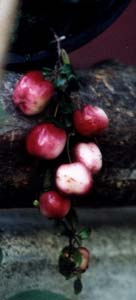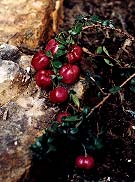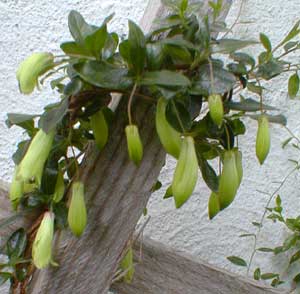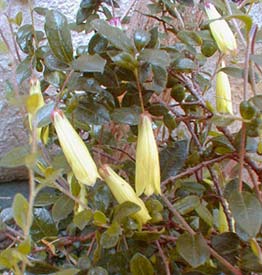
Purple Apple Berry; aka,
Tasmanian Climbing Blueberry
"I think of thee! -- my thoughts do twine & bud
About thee, as wild vines, about a tree."
-Elizabeth Barrett Browning
(1806-1861)
(1806-1861)
 The advice offered to me for planting two starts of Billardiera longiflora was that it should be trainted to a south-facing trellis. It also does well under a shrub it can climb up into.
The advice offered to me for planting two starts of Billardiera longiflora was that it should be trainted to a south-facing trellis. It also does well under a shrub it can climb up into.Without a place to climb, it will still do well as a trailing evergreen vine. I have seen it in one display garden climbing thickly up a sun-exposed four-foot fence.
It can climb to six feet & occasionally reaches ten feet, but we've started ours on a four-foot-tall rustic trellis which can have an extension screwed to it in the future if needed.
It likes rich well-draining moist soil, but is suprisingly drought-hardy when established, though slow-growing in droughtier positions. It can be tender in winter & may need protection from high winds.
We planted this native of Tasmania & New South Wales against the wall in a miniature rockery where it gets morning sun in winter & dappled sunlight the rest of the year when the Vine Maple is fully leafed, & where it has protection from high winds.
 Its roots are susceptible to heat & may need mulching to protect from sun, or some small shrub shading the root. Ours gets sufficient protection in summer from the Vine Maple's shade.
Its roots are susceptible to heat & may need mulching to protect from sun, or some small shrub shading the root. Ours gets sufficient protection in summer from the Vine Maple's shade.It tolerates a very little frost especially if it is trellised off the ground & sheltered, & is a true cool-climate evergreen vine. Still, a moderately extended cold snap will harm it.
As ours is climbing against the house, I think it will always have the protection it needs in winter even through the occasional cold snap.
If minimal pruning is ever necessary to restrict size or to rejuvenate the vine, this is done soon after fruiting is completed late in autumn or early winter.
 This uncommonly offered vine received the Award of Garden Merit from the Royal Horticultural Society. There's really nothing like it I've ever seen. The leaves are teency-tiny. The wiry vines age to semi-woodiness.
This uncommonly offered vine received the Award of Garden Merit from the Royal Horticultural Society. There's really nothing like it I've ever seen. The leaves are teency-tiny. The wiry vines age to semi-woodiness.In May through July it has greenish-yellow tubular trumpet-flowers that fade to lavender; the third photo shows large buds in May, the fourth shows the open flowers.
The marvelously unique purply-blue fruits resemble miniature one-inch eggplants both in appearance & texture. These ripen late summer through October, & continue to provide color to the garden through much of the winter.
Up to September's end, some of the fruits on our vines are purple & white, as shown in the first & fourth photos. But partway through October & by November, all the fruits are 100% purple, as shown in the second photo above right. Some of the fruits are fully purple by late August, as shown on the Apple Berry Page of the Berries Gallery.
 If the berries are to be harvested this should be done in late August or early September, as they become spongy & seedy inside as they age, & will soon be no longer tasty.
If the berries are to be harvested this should be done in late August or early September, as they become spongy & seedy inside as they age, & will soon be no longer tasty.When still somewhat firm, the seedy fruits taste a bit like apples hence the name Apple Berries, or as one word, Appleberry. I'm not terribly fond of their edibility raw, but fried & spiced, they are as tasty as eggplants or mushrooms. It's also nice to just leave them on the vines as strictly ornamental, since their visual appeal lasts into winter.
This would be an intriguing vine even without the highly unusual fruits, but with them, it's simply tremendous.
The genus is named for the French botanist, anthropologist, & naturalist Jaques Julien Houton de Labillardiere (1755-1834), whose puckish portrait is shown at the right. He explored Australia & published a multivolume study with his own illustrations, on the continent's flora, Novae Hollandiae Plantarum Specimen (1804-1807). Bruny Island's Labillardiere Peninsula in Tasmania is named for him.